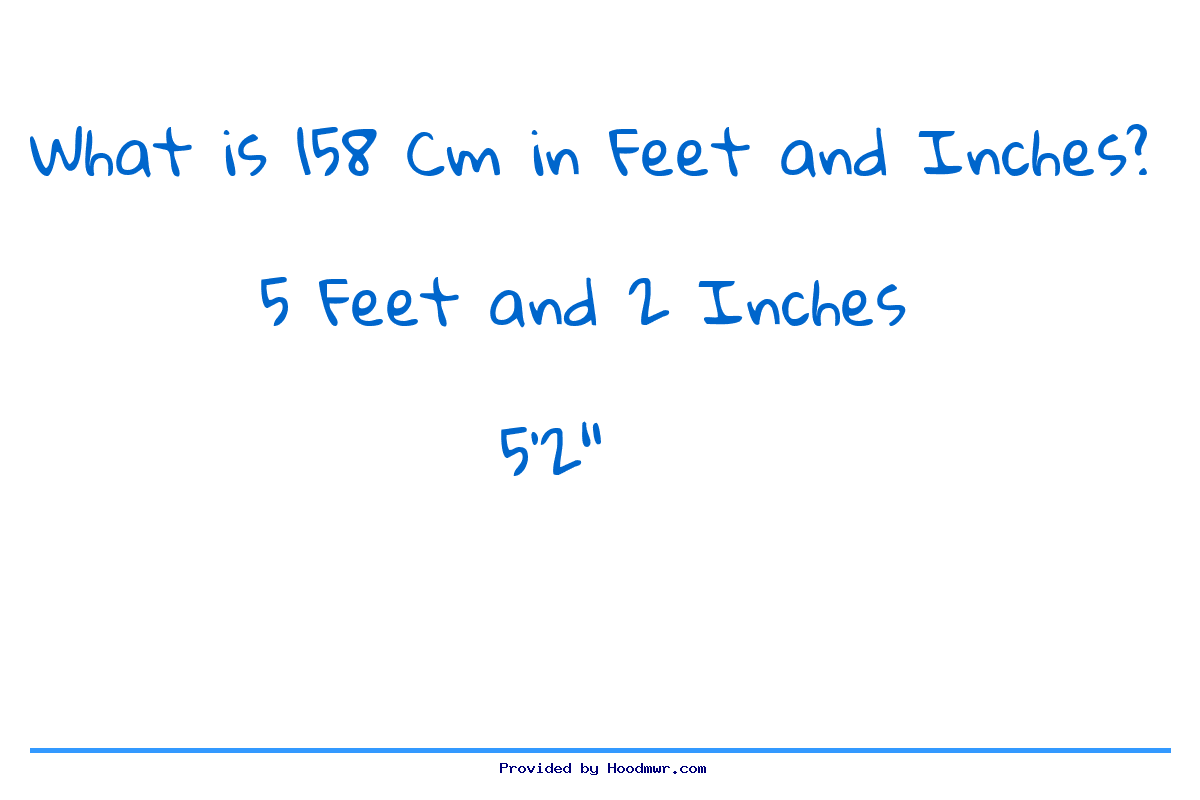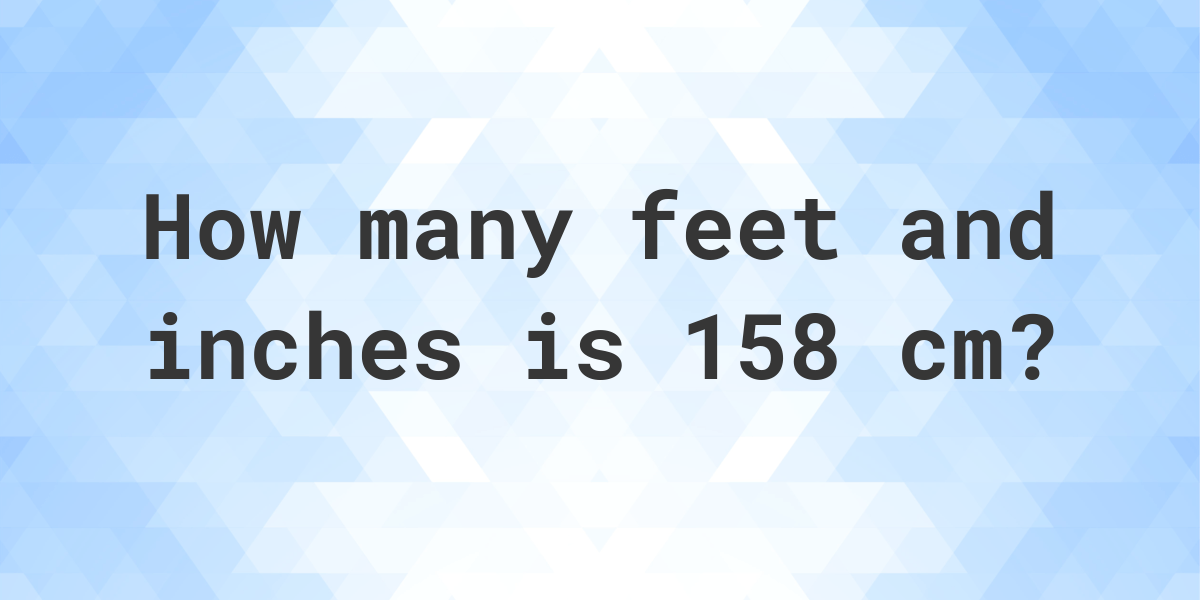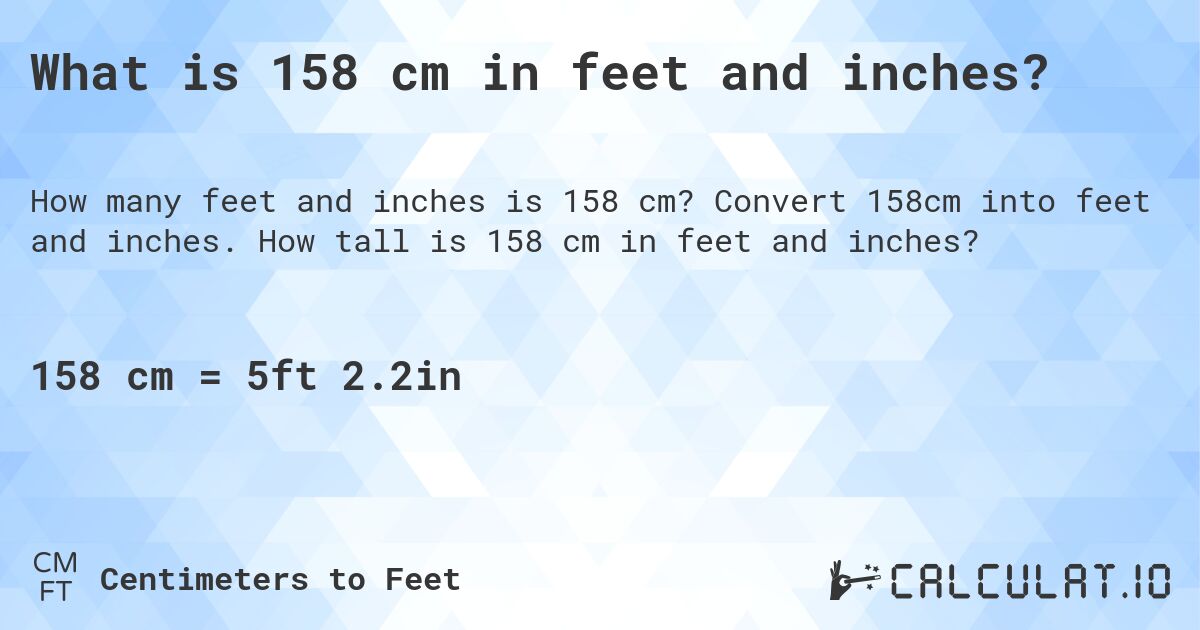Ever found yourself wondering just how tall 158 centimeters really is? It's a common question, especially when comparing yourself to global averages or trying to decipher those cryptic luggage dimensions. Let's unravel this metric mystery and see how it translates into the more familiar feet and inches.
So, what exactly is 158 centimeters in feet and inches? The answer, as precisely as possible, is 5 feet and 2.2 inches. Or, if you prefer decimals, that's 5.18 feet or 62.2 inches. But let's delve deeper than just the final number. There are several ways to arrive at this conversion, each offering a slightly different perspective on the relationship between these units of measurement. We'll explore formulas, practical applications, and even some quirky comparisons to make this conversion truly stick.
| Topic | Details |
|---|---|
| Conversion | 158 cm is approximately equal to 5 feet and 2.2 inches. |
| Formula | L (ft) = 158 cm 0.032808398950131 ft (where L is length in feet) |
| Unit Conversion | 1 cm 0.0328084 feet and 1 foot = 30.48 cm |
| Conversion Methods | Dividing centimeters by 30.48 to obtain feet, and converting any decimal feet to inches |
| Rounding | 158 cm can be rounded to 5 feet and 2 inches for simplicity |
| Luggage Size | Luggage with 158 cm linear dimensions is often considered a larger checked bag. |
| Height Comparison | This height falls within the normal range, but varies greatly across populations. |
| Conversion Formula from Inches to Centimeters | cm = inches 2.54 |
| Conversion Formula from Feet and Inches to Centimeters | cm = ((feet 12) + inches) 2.54 |
| Additional Conversions | 158 cm 5.18 feet, 62.2 inches, or in yards and miles. |
Let's start with the basics: understanding how to convert from centimeters to feet. The fundamental relationship is that 1 centimeter is equal to approximately 0.0328084 feet. Therefore, to convert 158 centimeters to feet, you multiply 158 by this conversion factor: 158 cm 0.0328084 ft/cm = 5.1837272 feet. This gives you the precise measurement in feet. But how do we break down that decimal into something more tangible, like inches?
- Best Remote Iot Raspberry Pi Setup Behind Router A Guide
- Michele Decesare Unveiling The Sopranos Star Beyond
The decimal part of the feet measurement (0.1837272 in this case) represents a fraction of a foot. To convert this to inches, we multiply it by 12, since there are 12 inches in a foot: 0.1837272 feet 12 inches/foot = 2.2047264 inches. So, there you have it: 158 centimeters is equal to 5 feet and approximately 2.2 inches.
Of course, there's a formula for that too. It is expressed as: L (ft) = 158 cm 0.032808398950131 ft. After calculation it gives: L (ft) = 5.1837270341207 ft. Another way to express it is: 158 cm 5.1837270341207 ft. In conclusion: 158 centimeters = 5.1837270341207 feet.
Now, let's consider another method. Instead of directly converting to feet and then to inches, we can work with the number of centimeters per foot. We know that 1 foot is equal to 30.48 centimeters. To find out how many feet are in 158 centimeters, we simply divide 158 by 30.48: 158 cm / 30.48 cm/foot = 5.18 feet. This result is, unsurprisingly, the same as before. The key here is understanding the inverse relationship between centimeters and feet.
- Girl Meets Farm New Episodes Renewal Updates Food Network
- Ai Undressing Best Tools Apps For Photo Editing Innovation
For those who prefer a more hands-on approach, imagine you have a ruler marked in both centimeters and feet. You would measure out 158 centimeters and then see where that falls on the feet scale. You'd find it's just over 5 feet. Then, you'd need to zoom in on that fractional part of a foot to determine the number of inches. This visual method can be helpful for those who struggle with abstract calculations.
Why does this conversion matter? Well, for starters, it's essential for comparing height across different countries. The metric system is widely used around the world, but in the United States, feet and inches remain the standard. Knowing how to convert between these systems allows you to understand and compare measurements regardless of the units used.
Furthermore, consider the practical applications. Let's say you're ordering clothing online from a European retailer. They might list the model's height in centimeters. To get a sense of how the clothes might fit you, you need to convert that height to feet and inches. The same goes for furniture, appliances, and other household items. Understanding the conversion helps you make informed purchasing decisions.
Another area where this conversion is particularly relevant is in travel. Many airlines have restrictions on the size of checked luggage, often expressed as the total linear dimensions (length + width + height) in centimeters. A common limit is 158 cm. So, before you pack your bags, you need to ensure that the sum of your bag's dimensions doesn't exceed this limit. Knowing how to quickly convert between centimeters and feet/inches can save you from having to pay hefty oversized baggage fees at the airport.
It's also worth noting that the average height of men varies significantly across different countries. To provide some context, let's compare 158 cm to average male heights in a few selected nations. Keep in mind that these are just averages, and individual heights can vary greatly.
In the Netherlands, for example, the average male height is around 182 cm (approximately 6 feet). So, 158 cm would be significantly below the average. In the United States, the average male height is about 175 cm (approximately 5 feet 9 inches), making 158 cm still shorter than average but not by as much. In Japan, the average male height is around 171 cm (approximately 5 feet 7 inches), again making 158cm shorter than the mean. The 158cm height would be considered in the shorter range for average height, even for South Korea men who has average height of around 175.3 cm. These comparisons highlight how relative height can be depending on the population you're considering.
Now, let's reverse the process. How do you convert from feet and inches to centimeters? The formula is as follows: centimeters = (feet 12 + inches) 2.54. So, if you wanted to convert 5 feet 2.2 inches to centimeters, you would first multiply 5 by 12 to get 60 inches. Then, you would add the additional 2.2 inches, resulting in 62.2 inches. Finally, you would multiply 62.2 by 2.54 to get 158 centimeters. This process allows you to move seamlessly between the two measurement systems.
But what if you only have the height in inches? For that, the conversion is even simpler: centimeters = inches * 2.54. This direct conversion is useful when you already know the total height in inches and just need to express it in centimeters.
Consider a few other height examples. 156.5cm is 5 feet 1.61 inches tall. 158.6cm in feet is 5.2034 feet, but when it is expressed in feet and inches is 5 feet and 2.44 inches. When 158cm is expressed in feet only it equals 5.18 ft, and in inches only 62.2 in. And when we express in yard and miles, we have to use conversion formula.
Let's look at some similar conversions:Here's a breakdown:6 feet and 2.8031 inches6 feet and 3.1969 inches6 feet and 3.5906 inches6 feet and 3.9843 inches6 feet and 4.378 inches6 feet and 4.7717 inches6 feet and 5.1654 inches6 feet and 5.5591 inches6 feet and 5.9528 inches6 feet and 6.3465 inches
Let's also not forget that these conversions are approximations. While the conversion factors are very precise, rounding errors can occur, especially when dealing with multiple steps. For most practical purposes, rounding to the nearest inch or tenth of an inch is sufficient. However, in scientific or engineering applications, it's crucial to use the most precise conversion factors available.
Now, let's touch on some related topics. What about converting other units of length? For example, how do you convert 50 cm to feet? Using the same conversion factor (1 cm = 0.0328084 ft), we find that 50 cm is equal to 1.64042 feet. Similarly, to convert 10 cm to feet, you simply divide 10 by 30.48, resulting in approximately 0.328 feet.
The historical context of these units of measurement is also interesting. Prior to standardization, the "foot" varied significantly in length across different cultures and time periods. The ancient Greeks, Romans, English, Chinese, and French all had their own versions of the foot, each with its own unique measurement. It wasn't until the modern era that a standardized foot was adopted, based on the metric system. So, when you're converting between centimeters and feet, you're not just dealing with numbers; you're also touching on a rich history of measurement and standardization.
In addition to height and luggage size, conversions between centimeters and feet/inches are useful in many other fields. Architects use these conversions when designing buildings and spaces. Interior designers use them when planning layouts and selecting furniture. Engineers use them when designing machines and structures. Even everyday tasks, like hanging pictures or installing shelves, can benefit from a solid understanding of these conversions.
For those who want to explore these conversions further, there are many online calculators and tools available. These tools allow you to quickly and easily convert between centimeters, feet, inches, meters, yards, and miles. Simply enter the value you want to convert, select the units, and the calculator will do the rest. These tools can be especially helpful when dealing with complex conversions or when you need to convert multiple values quickly.
It's also important to remember that the metric system is based on powers of 10, which makes conversions within the metric system relatively easy. For example, converting from centimeters to meters simply involves dividing by 100. However, converting between the metric system and the imperial system (which includes feet and inches) requires using the conversion factors we've discussed.
Another important thing to know is relationship between centimeters and meter. One meter is equal to 100 cm, or 3.2808398950131 feet. This fact is useful for learning the relationship between units. If you want to convert 158.4 centimeters to both feet and inches parts, then first you have to calculate whole number part for feet by rounding 158.4 / 30.48 fraction down. And then convert remainder of the division to inches by multiplying by 12 (according to feet to inches conversion formula )
If you are curios about how many gallons of water in a two and one half inch fire hose with 1.7 cubic feet (12.72 liquid gallons)? Also want to know the differences between 'wicked' and 'the wizard of oz?', then you can find answers on internet.
Furthermore, you can also explore different conversion based on situations. If you need to find out how many bricks would you need if area is 175 square feet and one brick is 4inchby8inch, you can find many online resources that can help you solve math problem.
Another question is: What is 126.856 round to the nearest tenths? What is the mode for numbers 27 4 9 2 10 0 18?
In conclusion, converting between centimeters and feet/inches is a fundamental skill with a wide range of practical applications. Whether you're comparing heights, packing luggage, ordering clothing, or designing a building, understanding these conversions will empower you to make informed decisions and navigate the world with greater confidence. So, the next time someone asks you how tall 158 centimeters is, you'll have the answer at your fingertips: it's 5 feet and 2.2 inches, a little over 5 feet, and an undeniably useful piece of information to know.



Detail Author:
- Name : Ms. Leslie Donnelly I
- Username : lorena.wuckert
- Email : abshire.victoria@towne.com
- Birthdate : 1981-03-01
- Address : 19622 Jennyfer Square Bahringerview, AR 66091-8404
- Phone : +1-901-286-3224
- Company : Hirthe, Howell and Maggio
- Job : Silversmith
- Bio : Molestiae veritatis doloribus qui rem. Animi rerum non cum sapiente. Sit reiciendis velit labore earum officia.
Socials
instagram:
- url : https://instagram.com/beau.kessler
- username : beau.kessler
- bio : Quaerat ab sint molestiae nemo. Voluptate et facilis consequatur.
- followers : 4353
- following : 982
linkedin:
- url : https://linkedin.com/in/bkessler
- username : bkessler
- bio : Inventore aut voluptas sed.
- followers : 4504
- following : 2104
tiktok:
- url : https://tiktok.com/@beau_kessler
- username : beau_kessler
- bio : Molestiae rerum quia eum dolorem repellendus officia ad.
- followers : 5188
- following : 2523